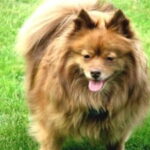“Does it not betray itself with its odor?” – Cicero
Humans often overlook the importance of the sense of smell because we rely so much on our eyes and our ears. Many animals rely on smell, taste and touch more than sight, especially those that live in complete blackness underground or complete whiteness of the Arctic wastes. But of all the species in the world, only two are allowed to use evidence based on their sense of smell in American courts – the human and one breed of dog, the bloodhound.
Brief History of the Bloodhound
The bloodhound was developed in Belgium, which is why sometimes they are called Flemish hounds. People in countries that predominantly speak French call a bloodhound the St. Hubert hound, after the legendary original breeder, St. Hubert (656 to 727 CE). He wanted a scent hound that strong enough to take down a stag. The dogs St. Hubert bred are thought to have not only originated the bloodhound but the Bassett hound and the foxhound.
It took a few countries for people to realize that the bloodhound’s incredibly ability to find prey also meant that they could find escaped prisoners or thieves. By the 1700s, bloodhounds were commonly used by gamekeepers to catch poachers. Police in the UK commonly walked their beats with their dogs. By the time of the notorious Jack the Ripper murders in 1888, bloodhounds were often used in police work. Bloodhounds were too friendly to bring down a prisoner, but at least they could point one out. One bloodhound named Nick Carter born in 1900 tracked and helped catch over 600 criminals.
Exceptional Nose
The bloodhound’s sense of smell is staggering. They have over 230 million olfactory receptor cells. This is 10 million more receptors than the average dog. In contrast, a rabbit possesses a mere 100 million and humans average 5.5 million. According to Bloodhounds (Barron’s Educational Series; 1998) the bloodhound has 22 inches of olfactory membrane or epithelium while a human has just one square inch.
Bloodhounds drool often, which continually moistens their epithelium. They were bred to have wrinkly faces to help trap scent. They were also bred to have long ears that touch the ground. Again, this is to help scoop up any scent particles and drive them towards that incredible nose. This means the bloodhound nose can detect minute particles of scent that most other animals would miss. Bloodhounds have been known to find a trail gone cold for 100 hours or 12 days. One bloodhound in Australia named Louisa Belle can sniff out bad wine corks, tainted wine through unopened bottles and mold on grape vines.
Resources
Palika, Liz. The Howell Book of Dogs. Howell Book House; 2010.
Thornton, Kim Campbell. Bloodhounds. Barron’s Educational Series; 1998.
Albrecht, Kathy. “Bloodhounds and Scent Evidence.”
Animal Planet. “Breed All About It: Bloodhounds”





